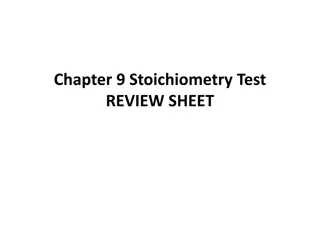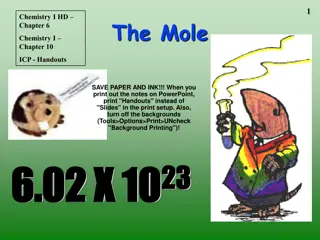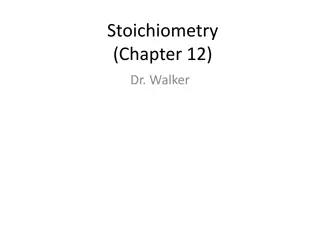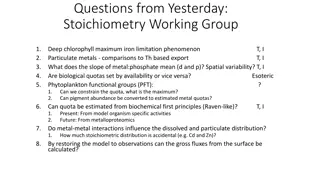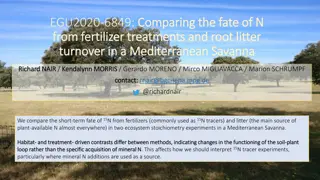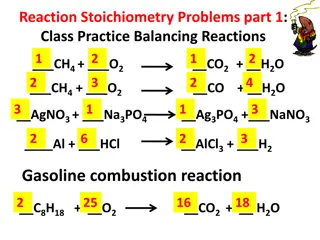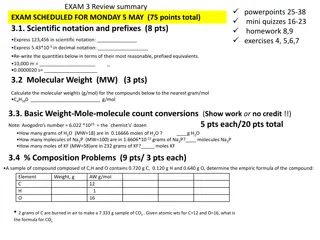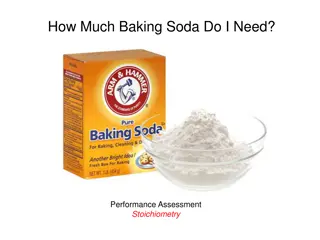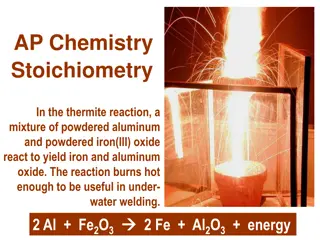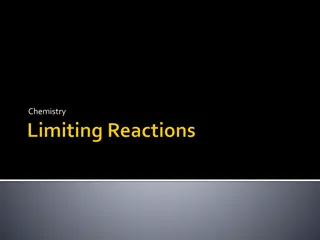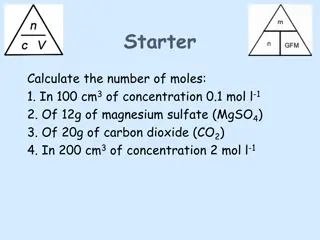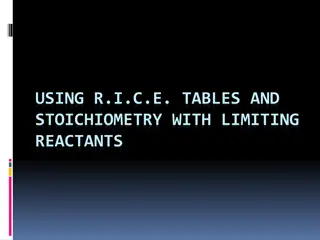Understanding Stoichiometry in Chemistry
Stoichiometry in chemistry involves calculating quantities of reactants and products in a chemical reaction based on a balanced equation. This process ensures the conservation of mass and atoms. Mole ratios are used as conversion factors, and steps such as converting to moles and applying the mole ratio are followed in stoichiometry problems. Practice problems and assessments help reinforce understanding of these concepts.
Download Presentation

Please find below an Image/Link to download the presentation.
The content on the website is provided AS IS for your information and personal use only. It may not be sold, licensed, or shared on other websites without obtaining consent from the author. Download presentation by click this link. If you encounter any issues during the download, it is possible that the publisher has removed the file from their server.
E N D
Presentation Transcript
Chapter 12: Stoichiometry Jennie L. Borders
Section 12.1 The Arithmetic of Equations A balanced chemical equation provides quantitative information. Chemists use balanced equations as a basis to calculate how much reactant is needed or product is formed in a reaction. The calculation of quantities in chemical reactions is called stoichiometry.
Balanced Equations + N2 3H2 2NH3 2 atoms N 1 m/c N2 6.02 x 1023m/c N2 1 mol N2 28g N2 22.4L N2 6 atoms H 3 m/c H2 1.806 x 1024m/c H2 3 mol H2 6g H2 67.2L H2 2 atoms N, 6 atoms H 2 m/c NH3 1.204 x 1024m/c NH3 2 mol NH3 34g NH3 44.8L NH3
Law of Conservation In a balanced chemical equation, only mass and number of atoms are conserved.
Section 12.1 Assessment 1. What quantities are always conserved in chemical reactions? 2. Interpret the given equation in terms of relative numbers of atoms, numbers of moles, and masses of the reactants and products. 2K + 2H2O 2KOH + H2 3. Balance the following equation and show how it obeys the law of conservation of mass. C2H5OH + O2 CO2 + H2O 3 2 3 142g 142g
Section 12.2 Chemical Calculations A mole ratio is a conversion factor derived from the coefficients of a balanced equation. Mole ratios are used to convert from one substance to another.
Sample Problem How many moles of ammonia are produced when 0.60 mol of nitrogen reacts with hydrogen? N2 + 3H2 2NH3 1.2 mol NH3
Practice Problems 4Al + 3O2 2Al2O3 How many moles of aluminum are needed to form 3.7 mol Al2O3? 7.4 mol Al How many moles of oxygen are required to react with 14.8 mol of Al? 11.1 mol O2 How many moles of Al2O3 are formed when 0.78 mol O2 reacts with aluminum? 0.52 mol Al2O3
Stoichiometry Problems When doing stoichiometry problems, you follow 3 steps. Step 1 convert to moles Step 2 mole ratio Step 3 convert to unit asked for Sometimes you can skip one or two steps.
Conversion Factors Remember that we have 3 conversion factors for the mole. 1 mol = 6.02 x 1023 r.p. 1 mol = molar mass 1 mol = 22.4L (at STP)
Sample Problem How many liters of acetylene gas (C2H2) at STP are produced by adding water to 5.00g CaC2? CaC2 + 2H2O C2H2 + Ca(OH)2 1.75L C2H2
Practice Problems How many molecules of oxygen are produced by the decomposition of 6.54g of potassium chlorate? 2KClO3 2KCl + 3O2 4.82 x 1022 m/c O2 How many grams of NH3 are produced by the reaction of 0.54 mol of hydrogen? N2 + 3H2 2NH3 6.12g NH3
Practice Problems How many molecules of oxygen are required to burn 3.86L of carbon monoxide? 2CO + O2 2CO2 5.19 x 1022 m/c O2 How many moles of phosphorus trihydride are formed when 0.42L of hydrogen reacts with phosphorus? P4 + 6H2 4PH3 0.0125 mol PH3
Section 12.2 Assessment 1. The combustion of acetylene gas is represented by the following equation. How many grams of CO2 and grams of H2O are produced when 2.56 mol C2H2 burns in oxygen? 2C2H2 + 5O2 4CO2 + 2H2O 225.28g CO2 and 46.08g H2O
Section 12.3 Limiting Reagent and Percent Yield In a chemical reaction, an insufficient quantity of any of the reactants will limit the amount of product that forms. BUILD A SANDWICH!
Limiting vs. Excess A limiting reagent is fully consumed in the reaction and determines the amount of product produced. An excess reagent is not fully consumed in the reaction, so some is left over.
Sample Problem What is the maximum number of grams of Cu2S that can be formed when 80.0g Cu reacts with 25.0g S? 2Cu + S Cu2S Total produced Limiting Reagent Cu produces 100.16g Cu2S S produces 124.22g Cu2S Excess Reagent
Practice Problems If 1.43 mol C2H4 is reacted with 2.61 mol O2, how many moles of CO2 is produced? C2H4 + 3O2 2CO2 + 2H2O LR = O2, ER = C2H4, total produced = 1.74 mol CO2 When 6.00 g HCl reacts with 5.00 g Mg, how many moles of magnesium chloride is produced? Mg + 2HCl MgCl2 + H2 LR = HCl, ER = Mg, total produced = 0.083 mol MgCl2
Percent Yield The theoretical yield is the maximum amount of product that can be formed from a given amount of reactants. (calculated) The actual yield is the amount of product that is produced in the lab.
Percent Yield The percent yield is the ratio of the actual yield to the theoretical yield times 100. Percent Yield = theoretical yield actual yield x 100 Since the theoretical yield is the maximum amount of product, the percent yield can never be over 100%.
Sample Problem What is the percent yield if 13.1g CaO is actually produced when 0.248 mol CaCO3 is heated? CaCO3 CaO + CO2 94.2%
Practice Problems If 50.0g of silicon dioxide is heated with an excess of carbon, 0.698 mol of silicon carbide is produced. What is the percent yield? SiO2 + 3C SiC + 2CO 83.8% When 0.044 mol Sb2S3 reacts with an excess of Fe, 0.081 mol Sb is produced. What is the percent yield of the reaction? Sb2S3 + 3Fe 2Sb + 3FeS 92%
Practice Problem If 15g of nitrogen reacts with 15g of hydrogen, 10.5g of ammonia is produced. What is the percent yield of the reaction? N2 + 3H2 2NH3 **Hint: This is a limiting reagent and percent yield problem. 57.7%
Section 12.3 Assessment In a chemical reaction, how does an insufficient quantity of a reactant affect the amount of product formed? What is the percent yield if 4.65g of copper is produced when 1.87g of aluminum reacts with an excess of copper (II) sulfate? 2Al + 3CuSO4 Al2(SO4)3 + 3Cu 70.5%



